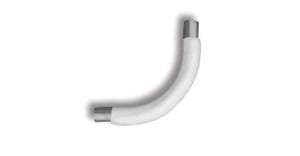July 1, 2019

The concept for dust collection is relatively simple: It is really just an industrial-sized “vacuum cleaner.” However, poor system operation can be expected if careful consideration to the five C’s is not made.
1. Capture
If you cannot effectively capture the dust, then your system has already failed. Both capture velocity and configuration are important parameters for design of pickup hoods. ACGIH (American Conference for Governmental Hygienists) provides helpful guidelines for recommended pickup hood capture velocities. ACGIH suggests a range of capture velocities depending upon the type and energy associated with the dust emission, including factors for dust toxicity or heavy production rates. For example, for wet sanding where heavy particulates are released from a high speed grinding wheel, a capture velocity of 2000 ft/min may be needed, whereas with a low-density dust may only need 200 ft/min.
Hood geometry and placement are critical too. A 2-in. hose pickup from a Shop-Vac is not sufficient to capture fugitive dust release during large drum filling. Rather, a semi-circular slotted manifold around the top perimeter of the drum will be more effective. With high momentum particle emissions, orient the pickup hood to capture the particle trajectory, thereby using the stream energy to capture the dust into the duct.
2. Convey
If you can’t effectively convey the dust, then you will not collect the dust, and will instead have duct plugging. Sufficient conveying velocity is required to pick up the dust from the pickup hoods and transport the material to the filter/collector for separation from the air stream.
Dusts require sufficient conveying velocity to transport the material in full suspension. The dust collection duct design should not be designed like a moving-bed dense phase conveying system, where dunes of material move slowly through the duct. Instead, an air velocity of about 4000 ft/min (or about 45 mph) is often needed. ACGIH lists a range of suggested duct design velocities.
Besides sufficient velocity, duct layout is just as critical. 90º branch entries, multiple elbows/entries in close proximity, and constant diameter ducting throughout should all be avoided.
3. Collect
If you can’t effectively collect the dust, then what is the point of designing/installing/running the dust collection system? Fans and positive displacement (PD) rotary blowers are used to provide the motive (suction) force for the dust collection system. Air mover vendors provide performance curves, via an on-line design tool, which demonstrate operating ranges for the mover under specified conditions (e.g., overall system resistance, air temperature, gas handled, altitude, fan speed, etc.).
Once you get the dust to the collector, the dust must be cleaned from the filters and reliably discharged. The collector must be sized to handle the volume of dirty-laden air, as well as dust loading in the hopper section during accumulation.
If the dust or collected bulk solid is allowed to accumulate in the hopper, and if the material is cohesive (tends to pack and stick to itself), then bridging and ratholing can result. These flow problems are the result of a hopper discharging material in an undesirable flow pattern. These problems can usually be avoided in a dust collector if the hopper is frequently emptied and a level of material is not allowed to accumulate. Controlled vibration or pulse air/inert gas sweeps may be needed to dislodge the dust adhered to the hopper walls.
4. Clean
If you can’t effectively clean the dust from the filters, then problems of particle bypass, clogging and plugging, and substantially reduced air flow occurs rendering dust pickup/conveying moot.
There are many types of separators to remove the dust from the gas stream, including: cyclones, baghouses, and cartridge collectors. Cyclones use inertial effects to separate the solids from the air stream, while baghouses and cartridge units use a physical media, like cloth, synthetic fabrics, or even sintered metal to capture the dust/solids until filter cleaning. Cyclones can be highly effective for separating large particles, such as wood chips, and can be highly useful with separating streams with hot and abrasive bulk solids given there are no moving parts or filters to damage. A baghouse or cartridge collector with a filter media can have collection efficiencies approaching 99.99%. The method of filter cleaning (e.g. on-demand differential; high/low pressure reverse pulse or flow) depends on the type of filter, collector, and process demands/impact.
Baghouses and cartridge filters must have sufficient filter area to clean the dust-laden air. Two important parameters for filter sizing are the “air-to-cloth” ratio (called face velocity) and can velocity, which is the speed of the dust-laden air as it passes upward between the filter bags. The air-to-cloth ratios are fairly standard for different types of collectors/filters and depend heavily upon the dust loading in the air stream, as well as particle size. If the can velocity is excessive, then previously removed dust from the filters will be rapidly pulled back onto the filters increasing cake buildup and reducing air flow through the filter.
5. Combustible dusts
Per research by FM Global, about 50% of dust explosions occur in the dust collector. As documented in NFPA (National Fire Protection Association) standard 652, Fundamentals of Combustible Dusts, the five ingredients needed for a dust explosion are:
1. combustible dust (fuel)
2. ignition (e.g., hot surface, friction, electrical spark or discharge)
3. dispersion
4. containment (dust explosion; if eliminated, hazard of flash fire NOT eliminated)
5. oxidant (typically oxygen)
There are several methods to address prevention and protection against a combustible dust explosion event: venting (NFPA 68); inerting/diluting of fuel or oxygen; suppressing; containing; and isolating (last four methods addressed in NFPA 69).
Given that 70% of all dusts can form explosible concentrations, it is prudent to evaluate if dust from your process can deflagrate (i.e., flash fire or explosion). Simple Go/No-go tests can be performed to evaluate this potential with more advanced testing available to determine event onset and to develop safety equipment and process design criteria. A Dust Hazards Analysis (DHA; NFPA 652, Chapter 7) must be performed within the next year or two to evaluate a process, equipment, and facility areas where fire, flash fire, and dust explosion hazards may exist. When a hazard is identified, safe operating ranges shall be defined, and safeguards shall be put in place to prevent or protect against the hazard.
Conclusion
As you go through the process of designing or troubleshooting a dust collection system, it is all too easy to focus on the individual components and not the interactions between the components. This is where expertise and experience can have a profound positive impact yielding an efficient, effective, and safely operating dust collection system.
Eric Maynard is a vice president at Jenike & Johanson Inc., Tyngsboro, MA. He is passionate about all aspects of bulk material storage, flow, pneumatic transport, mixing/blending/sampling, segregation, mechanical conveying, and combustible solids deflagration prevention. During his 23 years at J&J, Maynard has worked on more than 750 projects and has designed handling systems for bulk solids including chemicals, plastics, foods, pharmaceuticals, coal, biomass, cement, and other materials. He is the principal instructor for the AIChE courses “Flow of solids in bins, hoppers, chutes, and feeders” and “Pneumatic conveying of bulk solids.” For more information, call 978-649-3300, email [email protected], or visit jenike.com.
You May Also Like


